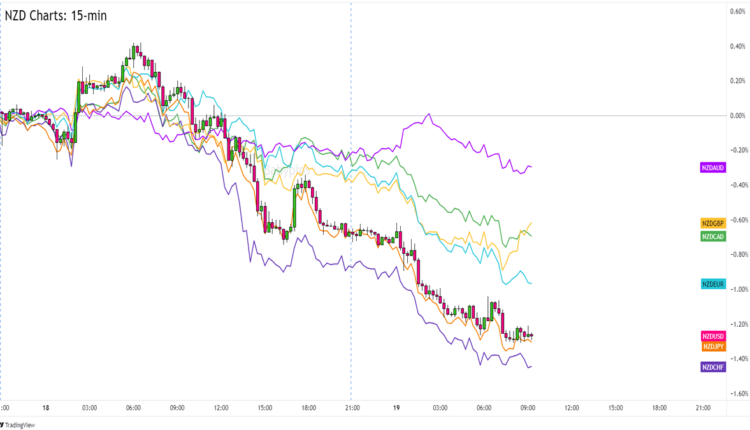Daily Forex News and Watchlist: AUD/USD
AUD/USD is almost at its October lows!
Will the pair drop a couple more pips to test its monthly support zone? Or will AUD/USD’s consolidation lead to a bit of upswing in the next trading sessions?
Before moving on, ICYMI, yesterday’s watchlist looked at EUR/AUD’s mid-channel resistance ahead of Australia’s jobs reports. Be sure to check out if it’s still a good play!
And now for the headlines that rocked the markets in the last trading sessions:
Fresh Market Headlines & Economic Data:
FOMC member Waller said on Wednesday that it is too soon to tell if more policy action is needed.
U.S. Building Permits for September: -4.4% m/m to 1.47M (-5.2% m/m forecast; 6.8% m/m previous)
U.S. housing starts rose by 7.0% m/m in September but higher mortgage rates could slow the momentum
EIA crude oil data showed a 4.5M barrels per day draw (vs. -0.5M expected, 10.2M increase in the previous week)
U.S. eased Venezuela’s oil sanctions after election deal
Japan’s trade deficit shrank from 0.55T JPY to 0.43T JPY as exports (4.3% y/y) hit record highs and outpaced imports (-16.3% y/y) in September
NAB: Australia’s quarterly business confidence improved by 3 pts to -1 in Q
Australia added a net of 6.7K jobs (vs. 20.6K expected, 63.3K previous) in September thanks to a 46.5K jump in part-time jobs offsetting the 39.9K decline in full-time employment
Australia’s unemployment rate slipped from 6.7% to 6.6% as the participation rate dropped from 67% to 66.7%
China’s new home prices dropped by 0.3% in September and marked the steepest decline since October 2022
Price Action News

Overlay of NZD vs. Major Currencies Chart by TradingView
Risk aversion was the name of the game during the Asian and early European sessions as traders focused on the lack of positive developments in the Middle East as well as their concerns over higher bond yields.
Data printed earlier also showed Australia’s labor market weakening in September while house prices in China dropped at their fastest rates in almost a year in September.
The Australian dollar took hits across the board but the New Zealand dollar saw sharper drops against its major counterparts. As of writing, NZD is weakest against USD, JPY, and EUR and has logged the fewest losses against AUD and GBP.
Upcoming Potential Catalysts on the Economic Calendar:
Canada’s producer price index at 12:30 pm GMT
U.S. initial jobless claims at 12:30 pm GMT
U.S. Philly Fed manufacturing index at 12:30 pm GMT
U.S. existing home sales at 2:00 pm GMT
FOMC Chairman Powell to give a speech at 4:00 pm GMT
New Zealand’s trade balance at 9:45 pm GMT
U.K.’s GfK consumer confidence at 11:01 pm GMT
PBoC’s 1 and 5-year loan prime rates at 1:15 am GMT (Oct 20)
Use our new Currency Heat Map to quickly see a visual overview of the forex market’s price action! 🔥 🗺️

AUD/USD 15-min Forex Chart by TradingView
As mentioned above, the New Zealand dollar juuuuust overtook the Australian dollar as the biggest loser among the major currencies so far today.
AUD is still pretty weak, though, with AUD/USD dropping from .6350 all the way to its current sub .6300 levels.
Are AUD/USD bears just taking a breather? Or has the pair seen its intraday lows today?
In the next few hours, we’ll see mid-tier U.S. reports like the initial jobless claims, existing home sales, and Philadelphia Fed’s manufacturing index. But all eyes will likely be on Fed Chairman Powell’s speech when he and his gang are expected to share less hawkish sentiments during the U.S. session.
Then, the next Asian session will open with the PBOC’s one and five-year loan prime rates. Both are expected to remain unchanged but surprise cuts may encourage risk-taking as it signals the government’s resolve to encourage domestic demand.
If today’s potential catalysts result in a risk-friendly trading environment, then AUD/USD could break above its consolidation and trade above the .6310 S1 Pivot Point level. It may even retest the .6350 Pivot Point line before the bears step in!
But if today’s events encourage more USD-buying and risk aversion, then AUD/USD may dip down to its .6290 October lows if not make new monthly lows.
Good luck and good trading this one!


Comments are closed.